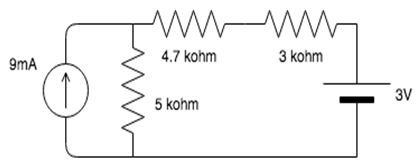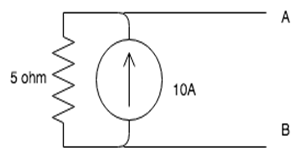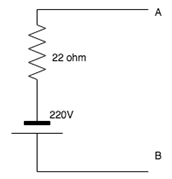This set of Basic Electrical Engineering Multiple Choice Questions & Answers (MCQs) focuses on “Source Transformations”.
1. A voltage source connected in series with a resistor can be converted to a?
a) Current source in series with a resistor
b) Current source in parallel with a resistor
c) Voltage source in parallel with a resistor
d) Cannot be modified
View Answer
Explanation: A voltage source connected in series can be converted to a current source connected in parallel using the relation obtained from Ohm’s law, that is V=IR. This equation shows that a voltage source connected in series has the same impact as a current source connected in parallel.
2. Calculate the total current in the circuit.

a) 2.3mA
b) 4.3mA
c) 3.3mA
d) 1.3mA
View Answer
Explanation: The 9mA source connected in parallel to the 5 kohm resistor can be converted to a 45V source in series with a 5 kohm resistor. Applying mesh analysis, we get:
I=(45-3)/(5+4.7+3) = 3.3mA.
3. Find the value of voltage once source transformation is applied to the circuit.

a) 10V
b) 30V
c) 50V
d) 70V
View Answer
Explanation: Using ohm’s law, we can use the relation: V=IR.
Thus V=10*5 = 50V.
4. Once the circuit is transformed to a voltage source where will the resistance be connected?

a) In series with the voltage source
b) In parallel with the voltage source
c) The resistance is removed from the circuit
d) Resistance is multiplied by 10 and connected in series with the source
View Answer
Explanation: The resistance is connected in series with the voltage source because we are transforming a current source connected in parallel to a resistor to a voltage source connected in series with it.
5. What will the value of the current be once source transformation is applied to the circuit?

a) 10A
b) 20A
c) 30A
d) 40A
View Answer
Explanation: Using ohm’s law, we can use the relation: V=IR.
Thus I=V/R.
I=220/22=10A.
6. Once the circuit is transformed into a current source where will the resistance be connected?

a) In series with the current source
b) In parallel with the current source
c) The resistance is removed from the circuit
d) Resistance is multiplied by 10 and connected in parallel with the source
View Answer
Explanation: When we perform source transformation on a circuit, we transform a voltage source connected in series with a resistor to a current source connected in parallel to it. This is due to the relation we get by Ohm’s law, that is V=IR.
7. A current source connected in parallel with a resistor can be converted to a?
a) Current source in series with a resistor
b) Voltage source in series with a resistor
c) Voltage source in parallel with a resistor
d) Cannot be modified
View Answer
Explanation: A current source connected in parallel can be converted to a voltage source connected in series using the relation obtained from Ohm’s law, that is V=IR. This equation shows that a current source connected in parallel has the same impact as a voltage source connected in series.
8. A source transformation is_________
a) Unilateral
b) Bilateral
c) Unique
d) Cannot be determined
View Answer
Explanation: A source transformation is bilateral because a voltage source can be converted to a current source and vice-versa.
9. In source transformation________
a) Voltage source remains the same
b) Current sources remain the same
c) Both voltage and current source remain the same
d) Resistances remain the same
View Answer
Explanation: In source transformation, the value of the voltage and current sources change when changed from voltage to current source and current to voltage source but the value of the resistance remains the same.
10. If there are 3 10V sources connected in parallel then on source transformation__________
a) The effect of all the sources is considered
b) The effect of only one source is considered
c) The effect of none of the sources is considered
d) The effect of only 2 sources is considered.
View Answer
Explanation: When voltages are connected in parallel, the effect of only one source is considered because the effect of the voltage remains the same when connected in parallel.
Sanfoundry Global Education & Learning Series – Basic Electrical Engineering.
To practice all areas of Basic Electrical Engineering, here is complete set of 1000+ Multiple Choice Questions and Answers.
If you find a mistake in question / option / answer, kindly take a screenshot and email to [email protected]
